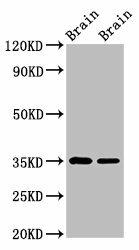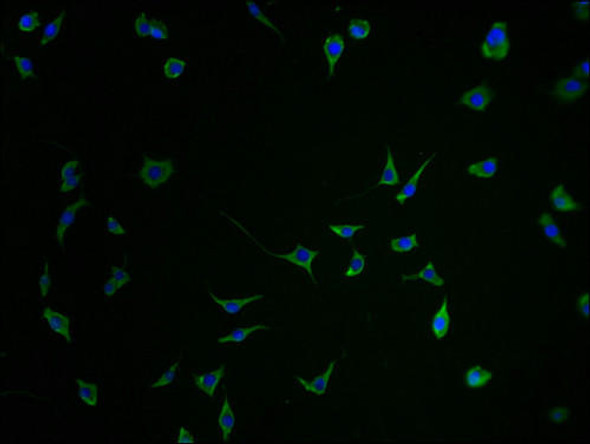Egln3 Antibody (PACO33512)
- SKU:
- PACO33512
- Product Type:
- Antibody
- Reactivity:
- Mouse
- Rat
- Host Species:
- Rabbit
- Isotype:
- IgG
- Applications:
- ELISA
- WB
- Antibody Type:
- Polyclonal Antibody
- Conjugation:
- Unconjugated
Description
Egln3 Antibody (PACO33512)
The EGLN3 Polyclonal Antibody (PAC033512) is a valuable tool for researchers studying EGLN3, a key player in the regulation of cellular response to hypoxia. This antibody, produced in rabbits, is highly specific to human samples and is validated for use in various applications, including Western blotting. By targeting the EGLN3 protein, this antibody allows for accurate detection and analysis in different cell types, making it an excellent choice for studies focusing on hypoxia and its implications in various disease states.EGLN3, also known as prolyl hydroxylase 3, is essential for the cellular adaptation to low oxygen levels, playing a crucial role in the regulation of hypoxia-inducible factor (HIF) stability and activity.
Dysregulation of EGLN3 has been implicated in numerous diseases, including cancer, cardiovascular disorders, and neurodegenerative conditions. By delving into the function of EGLN3, researchers can gain valuable insights into the mechanisms underlying these pathologies and potentially identify new therapeutic targets for intervention.Overall, the EGLN3 Polyclonal Antibody (PAC033512) is a reliable and efficient tool for exploring the role of EGLN3 in hypoxia response and its implications in disease, paving the way for advancements in the field of biomedical research.
| Antibody Name: | Egln3 Antibody (PACO33512) |
| Antibody SKU: | PACO33512 |
| Size: | 50ug |
| Host Species: | Rabbit |
| Tested Applications: | ELISA, WB |
| Recommended Dilutions: | ELISA:1:2000-1:10000, WB:1:500-1:5000 |
| Species Reactivity: | Mouse, Rat |
| Immunogen: | Recombinant Mouse Egl nine homolog 3 protein (2-239AA) |
| Form: | Liquid |
| Storage Buffer: | Preservative: 0.03% Proclin 300 Constituents: 50% Glycerol, 0.01M PBS, PH 7.4 |
| Purification Method: | >95%, Protein G purified |
| Clonality: | Polyclonal |
| Isotype: | IgG |
| Conjugate: | Non-conjugated |
 | Western Blot Positive WB detected in: Rat brain tissue, Mouse brain tissue All lanes: Egln3 antibody at 3.6µg/ml Secondary Goat polyclonal to rabbit IgG at 1/50000 dilution Predicted band size: 28 kDa Observed band size: 35 kDa . |
| Background: | Cellular oxygen sensor that catalyzes, under normoxic conditions, the post-translational formation of 4-hydroxyproline in hypoxia-inducible factor (HIF) α proteins. Hydroxylates a specific proline found in each of the oxygen-dependent degradation (ODD) domains (N-terminal, NODD, and C-terminal, CODD) of HIF1A. Also hydroxylates HIF2A. Has a preference for the CODD site for both HIF1A and HIF2A. Hydroxylation on the NODD site by EGLN3 appears to require prior hydroxylation on the CODD site. Hydroxylated HIFs are then targeted for proteasomal degradation via the von Hippel-Lindau ubiquitination complex. Under hypoxic conditions, the hydroxylation reaction is attenuated allowing HIFs to escape degradation resulting in their translocation to the nucleus, heterodimerization with HIF1B, and increased expression of hypoxy-inducible genes. ELGN3 is the most important isozyme in limiting physiological activation of HIFs (particularly HIF2A) in hypoxia. Also hydroxylates PKM in hypoxia, limiting glycolysis. Under normoxia, hydroxylates and regulates the stability of ADRB2. Regulator of cardiomyocyte and neuronal apoptosis. In cardiomyocytes, inhibits the anti-apoptotic effect of BCL2 by disrupting the BAX-BCL2 complex. In neurons, has a NGF-induced proapoptotic effect, probably through regulating CASP3 activity. Also essential for hypoxic regulation of neutrophilic inflammation. |
| Synonyms: | Egl nine homolog 3 (EC 1.14.11.29) (Hypoxia-inducible factor prolyl hydroxylase 3) (HIF-PH3) (HIF-prolyl hydroxylase 3) (HPH-3) (Prolyl hydroxylase domain-containing protein 3) (PHD3) (SM-20), Egln3 |
| UniProt Protein Function: | EGLN3: Cellular oxygen sensor that catalyzes, under normoxic conditions, the post-translational formation of 4-hydroxyproline in hypoxia-inducible factor (HIF) alpha proteins. Hydroxylates a specific proline found in each of the oxygen-dependent degradation (ODD) domains (N-terminal, NODD, and C-terminal, CODD) of HIF1A. Also hydroxylates HIF2A. Has a preference for the CODD site for both HIF1A and HIF2A. Hydroxylation on the NODD site by EGLN3 appears to require prior hydroxylation on the CODD site. Hydroxylated HIFs are then targeted for proteasomal degradation via the von Hippel-Lindau ubiquitination complex. Under hypoxic conditions, the hydroxylation reaction is attenuated allowing HIFs to escape degradation resulting in their translocation to the nucleus, heterodimerization with HIF1B, and increased expression of hypoxy-inducible genes. EGLN3 is the most important isozyme in limiting physiological activation of HIFs (particularly HIF2A) in hypoxia. Also hydroxylates PKM in hypoxia, limiting glycolysis. Under normoxia, hydroxylates and regulates the stability of ADRB2. Regulator of cardiomyocyte and neuronal apoptosis. In cardiomyocytes, inhibits the anti-apoptotic effect of BCL2 by disrupting the BAX-BCL2 complex. In neurons, has a NGF-induced proapoptotic effect, probably through regulating CASP3 activity. Also essential for hypoxic regulation of neutrophilic inflammation.Protein type: Oxidoreductase; EC 1.14.11.29Cellular Component: cytoplasm; nucleus; cytosolMolecular Function: peptidyl-proline dioxygenase activity; dioxygenase activity; L-ascorbic acid binding; oxidoreductase activity, acting on paired donors, with incorporation or reduction of molecular oxygen; metal ion binding; iron ion binding; oxidoreductase activity, acting on paired donors, with incorporation or reduction of molecular oxygen, 2-oxoglutarate as one donor, and incorporation of one atom each of oxygen into both donors; oxidoreductase activity; peptidyl-proline 4-dioxygenase activityBiological Process: apoptosis; regulation of neuron apoptosis; response to hypoxia; peptidyl-proline hydroxylation; protein amino acid hydroxylation; peptidyl-proline hydroxylation to 4-hydroxy-L-proline; response to DNA damage stimulus; regulation of cell proliferation |
| UniProt Protein Details: | |
| NCBI Summary: | |
| UniProt Code: | Q91UZ4 |
| NCBI GenInfo Identifier: | 269308213 |
| NCBI Gene ID: | 112407 |
| NCBI Accession: | NP_082409.2 |
| UniProt Secondary Accession: | Q91UZ4,Q3TCG8, Q8C8M6, Q8CCA8, Q8R5C7 |
| UniProt Related Accession: | Q91UZ4 |
| Molecular Weight: | 27,302 Da |
| NCBI Full Name: | egl nine homolog 3 |
| NCBI Synonym Full Names: | egl-9 family hypoxia-inducible factor 3 |
| NCBI Official Symbol: | Egln3 |
| NCBI Official Synonym Symbols: | Phd3; SM-20; AI505553; AI648162; Hif-p4h-3; 2610021G09Rik |
| NCBI Protein Information: | egl nine homolog 3 |
| UniProt Protein Name: | Egl nine homolog 3 |
| UniProt Synonym Protein Names: | Hypoxia-inducible factor prolyl hydroxylase 3; HIF-PH3; HIF-prolyl hydroxylase 3; HPH-3; Prolyl hydroxylase domain-containing protein 3; PHD3; SM-20 |
| Protein Family: | Egl nine |
| UniProt Gene Name: | Egln3 |
| UniProt Entry Name: | EGLN3_MOUSE |










